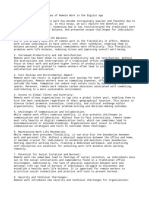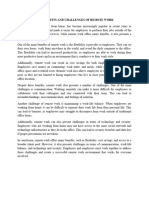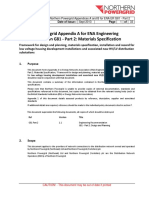Advantages and Disadvantages of Remote Working
Advantages and Disadvantages of Remote Working
Uploaded by
Thoa LeCopyright:
Available Formats
Advantages and Disadvantages of Remote Working
Advantages and Disadvantages of Remote Working
Uploaded by
Thoa LeCopyright
Available Formats
Share this document
Did you find this document useful?
Is this content inappropriate?
Copyright:
Available Formats
Advantages and Disadvantages of Remote Working
Advantages and Disadvantages of Remote Working
Uploaded by
Thoa LeCopyright:
Available Formats
Tho@le- TASK 2. IELTS WRITING.
REMOTE WORKING
ADVANTAGES AND DISADVANTAGES OF REMOTE WORKING
Remote working, also referred to as telecommuting or working from home, has become increasingly popular in recent
years. With advancements in technology, many individuals now have the ability to complete their work tasks from the
comfort of their own homes or from any location outside of a traditional office setting. While remote working offers
several benefits, it also presents certain challenges. In this article, we will explore both the advantages and disadvantages
of remote working.
Advantages of Remote Working
1. Flexibility: One of the primary advantages of remote working is the flexibility it provides. Remote workers
have the ability to set their own schedules, allowing them to work during their most productive hours. This
flexibility can also be beneficial for individuals with personal commitments or obligations outside of work.
2. Increased Productivity: Remote working can lead to increased productivity for many individuals. Without the
distractions of a traditional office environment, remote workers can often focus more intently on their tasks and
complete them more efficiently. Additionally, remote workers have the flexibility to create a work environment
that suits their specific needs, further enhancing their productivity.
3. Reduced Commute Time and Expenses: Remote workers are able to eliminate the daily commute to and from
the office. This not only saves valuable time but also reduces expenses associated with transportation, such as
gas costs and parking fees. Eliminating the commute can also contribute to a greener environment by reducing
pollution from vehicles.
4. Improved Work-Life Balance: Remote working can contribute to an improved work-life balance. With the
ability to work from home, individuals can allocate more time to their personal lives, such as spending time
with family, pursuing hobbies, or engaging in self-care activities. This balance can lead to increased job
satisfaction and overall well-being.
Disadvantages of Remote Working
1. Lack of Social Interaction: One of the main disadvantages of remote working is the lack of social interaction.
Working from home can be isolating, as remote workers may not have the same opportunities for workplace
socialization and collaboration as their office-based colleagues. This lack of interaction can impact teamwork
and camaraderie within a remote team.
2. Potential for Distractions: While remote working eliminates the distractions of a traditional office environment,
it can also introduce new distractions. Remote workers may face interruptions from family members, household
chores, or other responsibilities. It requires self-discipline and effective time management to maintain focus and
avoid such distractions.
3. Communication Challenges: Communication can be more challenging in a remote work setting. Without face-
to-face interaction, remote workers must rely heavily on digital communication tools such as email, instant
messaging, and video conferencing. Miscommunication can occur more easily in these mediums, leading to
delays or misunderstandings in the completion of tasks.
4. Blurred Boundaries Between Work and Personal Life: Remote working can blur the boundaries between work
and personal life. When working from home, it can be challenging to separate work tasks from personal
responsibilities, resulting in longer working hours and increased stress. It is important for remote workers to
establish boundaries and create a dedicated workspace to maintain a healthy work-life balance.
In conclusion, remote working offers several advantages such as flexibility, increased productivity, reduced commute time
and expenses, and improved work-life balance. However, it also presents challenges such as lack of social interaction,
potential distractions, communication difficulties, and blurred boundaries between work and personal life. It is essential
for individuals considering remote working to carefully weigh these factors and determine if remote working is a suitable
option for their specific needs and preferences.
Solutions to Overcoming the Challenges of Remote Working
Remote working has become increasingly common in today's digital age. While it provides many benefits such as
flexibility and convenience, it also presents several challenges that individuals need to overcome. In this article, we will
explore some measures that can be taken to solve the obstacles of remote working.
Establish a Dedicated Workspace
One of the first measures to consider is establishing a dedicated workspace at home. Having a designated area where you
can focus on your work can greatly enhance productivity and minimize distractions. Ensure that your workspace is
comfortable and well-equipped with the necessary tools and resources.
Tho@le- TASK 2. IELTS WRITING. REMOTE WORKING
Set Clear Boundaries
When working remotely, it can be challenging to maintain a work-life balance. It is crucial to establish clear boundaries
between work and personal life. Define specific working hours and communicate them to your colleagues, clients, and
family members. Respect these boundaries and avoid taking work-related tasks beyond the established working hours.
Maintain Communication Channels
Effective communication is essential for successful remote work. Utilize various communication channels such as email,
instant messaging, video conferencing, and project management tools to stay connected with your team. Regularly check
in with your colleagues, provide updates on your progress, and address any challenges or concerns promptly.
Manage Time Effectively
Remote working requires self-discipline and effective time management skills. Create a schedule or to-do list to prioritize
tasks and stay organized. Break down larger projects into smaller, manageable tasks to avoid feeling overwhelmed. Set
deadlines for yourself and ensure that you meet them consistently.
Stay Motivated and Engaged
Working remotely can sometimes lead to feelings of isolation and reduced motivation. Find ways to stay engaged and
motivated in your work. Set goals and reward yourself upon their completion. Participate in virtual team-building
activities or online networking events to connect with others in your field. Seek opportunities for professional
development and continuous learning to stay inspired.
Prioritize Self-Care
Taking care of your physical and mental well-being is essential when working remotely. Maintain a healthy lifestyle by
exercising regularly, eating nutritious meals, and getting enough sleep. Take regular breaks throughout the day to rest and
recharge. Engage in activities that help you relax and reduce stress, such as practicing mindfulness or pursuing hobbies.
Seek Support and Collaboration
Don't hesitate to reach out for support or collaborate with others when facing challenges while working remotely. Connect
with your colleagues or join virtual communities related to your industry to share experiences and seek advice.
Collaborate on projects or brainstorm ideas with your teammates to foster a sense of teamwork and camaraderie.
In conclusion, while remote working offers numerous advantages, it is not without its challenges. By implementing
measures such as establishing a dedicated workspace, setting clear boundaries, maintaining effective communication
channels, managing time effectively, staying motivated and engaged, prioritizing self-care, and seeking support and
collaboration, individuals can overcome the obstacles of remote working and enjoy a productive and fulfilling remote
work experience.
Remember, working remotely requires adaptability, resilience, and self-discipline, but with the right measures in place, it
can be a rewarding and successful endeavor.
You might also like
- Hyperconverged Infrastructure For Dummies 2019 Edition PDFDocument65 pagesHyperconverged Infrastructure For Dummies 2019 Edition PDFAlex Irmel Oviedo Solis100% (1)
- How To Work Remotely (Your Complete Guide) - LifeHackDocument26 pagesHow To Work Remotely (Your Complete Guide) - LifeHackyigam51960No ratings yet
- Νέο Έγγραφο Του Microsoft WordDocument2 pagesΝέο Έγγραφο Του Microsoft Wordgianns200523No ratings yet
- PutraDocument4 pagesPutradtp31061No ratings yet
- The Benefits and Challenges of Remote WorkDocument2 pagesThe Benefits and Challenges of Remote WorkerkanaptiNo ratings yet
- Remote Work Vs TelecommutingDocument3 pagesRemote Work Vs TelecommutingJaeNo ratings yet
- Lektura Prasy ArtykułDocument2 pagesLektura Prasy Artykułsteamimon2No ratings yet
- The Impact of Remote Work On Work-Life BalanceDocument2 pagesThe Impact of Remote Work On Work-Life BalancenavinpkujurNo ratings yet
- From Isolation to Balance: The Ultimate Guide to Remote Work SuccessFrom EverandFrom Isolation to Balance: The Ultimate Guide to Remote Work SuccessNo ratings yet
- Here 5Document2 pagesHere 5Battle SagaNo ratings yet
- The Advantages and Challenges of Remote WorkDocument3 pagesThe Advantages and Challenges of Remote WorkKane PleaseNo ratings yet
- Comprehensive Speaking Seminar of The WeekDocument3 pagesComprehensive Speaking Seminar of The Weekthuy94575No ratings yet
- Wa0001.Document5 pagesWa0001.Sachin SharmaNo ratings yet
- The Rise of Remote Work-Redefining The Modern WorkplaceDocument2 pagesThe Rise of Remote Work-Redefining The Modern Workplacekjsingh01No ratings yet
- Remote Working v2Document3 pagesRemote Working v2simaykoc.skNo ratings yet
- The Impact of Remote Work On Employee Performance and WellDocument2 pagesThe Impact of Remote Work On Employee Performance and WellDrazen JovicNo ratings yet
- ManageDocument8 pagesManageFaheem GulNo ratings yet
- The Future of Remote Work: Pros and ConsDocument3 pagesThe Future of Remote Work: Pros and Consyrfgdvb27No ratings yet
- Navigating The Remote Work RevolutionDocument8 pagesNavigating The Remote Work Revolutionsarfrazahmed34357No ratings yet
- The Benefits and Challenges of Remote WorkDocument2 pagesThe Benefits and Challenges of Remote WorkJuan BrattiNo ratings yet
- Work From HomeDocument17 pagesWork From Home5trrz6p9gzNo ratings yet
- HRM PresentationDocument14 pagesHRM Presentationishasingh02004No ratings yet
- Working From HomeDocument4 pagesWorking From Home23521346No ratings yet
- Rise of Remote WorkDocument4 pagesRise of Remote WorkJosiah DalisayNo ratings yet
- 2 Advantage and DisadvantageDocument19 pages2 Advantage and DisadvantageMariam MiliNo ratings yet
- Toeic Writing Q11 Tham KH oDocument19 pagesToeic Writing Q11 Tham KH oTrần Ngọc NhiNo ratings yet
- Remote Work Pros and ConsDocument1 pageRemote Work Pros and ConssfgNo ratings yet
- Emerging TrendsDocument13 pagesEmerging TrendsSanjeevani BasuNo ratings yet
- Work - Life BalanceDocument3 pagesWork - Life Balancespring lookNo ratings yet
- Learning Unit 1Document11 pagesLearning Unit 1tsholofelokeikelame3No ratings yet
- The Rise of Remote WorkDocument2 pagesThe Rise of Remote WorkbarteksribdNo ratings yet
- Effective Telecommuting: Learn how to work efficiently and productively at homeFrom EverandEffective Telecommuting: Learn how to work efficiently and productively at homeNo ratings yet
- @annisuphere #Idea Sheet - Future of Remote WorkDocument12 pages@annisuphere #Idea Sheet - Future of Remote WorkninaNo ratings yet
- Mastering Remote Work: This comprehensive guide empowers you to succeed in the world of remote work.From EverandMastering Remote Work: This comprehensive guide empowers you to succeed in the world of remote work.No ratings yet
- RecupDocument16 pagesRecupkangadaniel0887No ratings yet
- MR Milleur 3Document16 pagesMR Milleur 3kangadaniel0887No ratings yet
- Remote Work ChallengesDocument2 pagesRemote Work ChallengesSunaiyna VarmaNo ratings yet
- Reflection Essay - HRM533Document9 pagesReflection Essay - HRM533Mazatul NadirahNo ratings yet
- TeleworkingDocument6 pagesTeleworkingКарина КолесникNo ratings yet
- Remote Work During COVID-19 On 2021Document6 pagesRemote Work During COVID-19 On 2021Keren H. Morales RomeroNo ratings yet
- How to Maximize Your Day: Stop Wasting Time and Start Living a Productive LifeFrom EverandHow to Maximize Your Day: Stop Wasting Time and Start Living a Productive LifeRating: 5 out of 5 stars5/5 (1)
- Impact of Remote Work On Productivity and Work-Life BalanceDocument2 pagesImpact of Remote Work On Productivity and Work-Life Balance022MausamNo ratings yet
- Oum Business SchoolDocument6 pagesOum Business SchoolMadhu SudhanNo ratings yet
- The Benefits and Challenges of Remote Wor1Document2 pagesThe Benefits and Challenges of Remote Wor1AngBagong Barangay SanJuanNo ratings yet
- Evaluate The Benefits and Difficulties of Working From HomeDocument3 pagesEvaluate The Benefits and Difficulties of Working From Homeeman abdelhaqNo ratings yet
- Case Study 1Document10 pagesCase Study 1Zuraida NurdinNo ratings yet
- Cons Work From HomeDocument2 pagesCons Work From HomeAyeshaNo ratings yet
- Chap16 Work HabitsDocument5 pagesChap16 Work Habitsapi-3728461100% (1)
- The Benefits and Challenges of Remote Work in The Digital AgeDocument3 pagesThe Benefits and Challenges of Remote Work in The Digital AgeJas PerNo ratings yet
- Emerging Trends in HRDocument3 pagesEmerging Trends in HRsumesh.menasseryNo ratings yet
- WFH Guidelines For Employees & EmployersDocument6 pagesWFH Guidelines For Employees & EmployersMohana SundaramNo ratings yet
- Essay 4Document1 pageEssay 4flitzzgaming3112No ratings yet
- The Benefits and Drawbacks of Remote WorkDocument1 pageThe Benefits and Drawbacks of Remote Workganji98No ratings yet
- The Benefits and Challenges of Remote WorkDocument1 pageThe Benefits and Challenges of Remote WorkAngBagong Barangay SanJuanNo ratings yet
- Elective Assignment Time Management AbdirizakDocument5 pagesElective Assignment Time Management Abdirizakxalwoqaali2018No ratings yet
- Test 1Document12 pagesTest 1Thoa LeNo ratings yet
- Ngân Hàng Các Cấu Trúc Tiếng Anh Thông DụngDocument5 pagesNgân Hàng Các Cấu Trúc Tiếng Anh Thông DụngThoa LeNo ratings yet
- Thoa Le-Nguyen Huu Huan Hogh SchoolDocument5 pagesThoa Le-Nguyen Huu Huan Hogh SchoolThoa LeNo ratings yet
- Thoa Le-Nguyen Huu Huan High SchoolDocument5 pagesThoa Le-Nguyen Huu Huan High SchoolThoa LeNo ratings yet
- Ade12 1201Document6 pagesAde12 1201Thoa LeNo ratings yet
- ASSIGNMENT NO - 01 New MarketingDocument23 pagesASSIGNMENT NO - 01 New MarketingabcdNo ratings yet
- Bulgaria AML PDFDocument6 pagesBulgaria AML PDFMadalina IftodeNo ratings yet
- CH 18 Wiley Kimmel Quiz HomeworkDocument14 pagesCH 18 Wiley Kimmel Quiz Homeworkmki60% (5)
- D102075GC10 sg2 PDFDocument240 pagesD102075GC10 sg2 PDFSegun AdireNo ratings yet
- Digital Banking The Future of BankingDocument25 pagesDigital Banking The Future of BankingHIMANSHU RAWATNo ratings yet
- 9.1 Overview of The Cost of CapitalDocument21 pages9.1 Overview of The Cost of CapitalTawan VihokratanaNo ratings yet
- A Study On Organizational Citizenship Behaviour atDocument95 pagesA Study On Organizational Citizenship Behaviour atravigos1982No ratings yet
- MEX-Fire Rated DoorsDocument7 pagesMEX-Fire Rated DoorsshahzadNo ratings yet
- Hero MotoCorp - WikipediaDocument53 pagesHero MotoCorp - Wikipediavishalucky073No ratings yet
- Aerospace Material Specification: AMS4310™ Rev. FDocument6 pagesAerospace Material Specification: AMS4310™ Rev. FMohammad LavasaniNo ratings yet
- 2 - Asia Pacific Rail 2019 - Post Event ReportDocument36 pages2 - Asia Pacific Rail 2019 - Post Event ReportJigisha VasaNo ratings yet
- Vision IAS Prelims Test 34 Questions 2022Document20 pagesVision IAS Prelims Test 34 Questions 2022Raj RathoreNo ratings yet
- Sample Speculative Cover Letter EmailDocument8 pagesSample Speculative Cover Letter Emaildut0s0hitan3100% (2)
- Guidelinesfor Food HandlingDocument26 pagesGuidelinesfor Food HandlingblackicemanNo ratings yet
- Transportation Law Course Outline 3Document16 pagesTransportation Law Course Outline 3NarniaNo ratings yet
- Acca 2.4 Revision Question BankDocument6 pagesAcca 2.4 Revision Question BankJoy Nelson-Graham50% (2)
- Fiinratings Monthly Report January 2024Document7 pagesFiinratings Monthly Report January 2024ducnguyentcbNo ratings yet
- HP2.EOU TEST U10 PreInterDocument4 pagesHP2.EOU TEST U10 PreInterMinh Hải TrầnNo ratings yet
- Merchant Termination Form - Paydee SDN BHDDocument1 pageMerchant Termination Form - Paydee SDN BHDKeerthiga ManoharanNo ratings yet
- E Commerce 8 Units NotesDocument91 pagesE Commerce 8 Units Notespavanjammula100% (5)
- ZTE TechnologiesDocument40 pagesZTE TechnologiesGayan WeerasingheNo ratings yet
- Conflict of Laws Digest 1Document18 pagesConflict of Laws Digest 1Jan Re Espina CadeleñaNo ratings yet
- Confidentiality AgreementDocument9 pagesConfidentiality AgreementinfoNo ratings yet
- Aregay Editd ProposalDocument25 pagesAregay Editd ProposalFasiko AsmaroNo ratings yet
- COEM 6009 Coursework Assignment For Neil BeeraspatDocument30 pagesCOEM 6009 Coursework Assignment For Neil Beeraspatneil beeraspatNo ratings yet
- Multiple Choice QuestionsDocument10 pagesMultiple Choice QuestionsDarshitNo ratings yet
- Northern Powergrid Appendix A For ENA Engineering Recommendation G81 Part 2: Materials SpecificationDocument33 pagesNorthern Powergrid Appendix A For ENA Engineering Recommendation G81 Part 2: Materials SpecificationFoaad AhmadNo ratings yet
- Shravya Sharma: Phone: 9008366227Document4 pagesShravya Sharma: Phone: 9008366227Lavanya SharmaNo ratings yet
- TranslateDocument2 pagesTranslateBalmukund KumarNo ratings yet






























































































